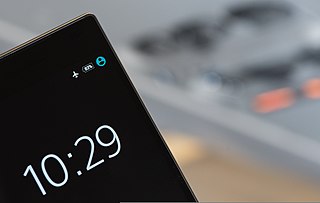Related Research Articles

A wireless LAN (WLAN) is a wireless computer network that links two or more devices using wireless communication to form a local area network (LAN) within a limited area such as a home, school, computer laboratory, campus, or office building. This gives users the ability to move around within the area and remain connected to the network. Through a gateway, a WLAN can also provide a connection to the wider Internet.

Wi-Fi is a family of wireless network protocols based on the IEEE 802.11 family of standards, which are commonly used for local area networking of devices and Internet access, allowing nearby digital devices to exchange data by radio waves. These are the most widely used computer networks, used globally in home and small office networks to link devices and to provide Internet access with wireless routers and wireless access points in public places such as coffee shops, hotels, libraries, and airports.

Wireless communication is the transfer of information (telecommunication) between two or more points without the use of an electrical conductor, optical fiber or other continuous guided medium for the transfer. The most common wireless technologies use radio waves. With radio waves, intended distances can be short, such as a few meters for Bluetooth, or as far as millions of kilometers for deep-space radio communications. It encompasses various types of fixed, mobile, and portable applications, including two-way radios, cellular telephones, personal digital assistants (PDAs), and wireless networking. Other examples of applications of radio wireless technology include GPS units, garage door openers, wireless computer mouse, keyboards and headsets, headphones, radio receivers, satellite television, broadcast television and cordless telephones. Somewhat less common methods of achieving wireless communications involve other electromagnetic phenomena, such as light and magnetic or electric fields, or the use of sound.

Wardriving is the act of searching for Wi-Fi wireless networks as well as cell towers, usually from a moving vehicle, using a laptop or smartphone. Software for wardriving is freely available on the internet.
Linksys Holdings, Inc., is an American brand of data networking hardware products mainly sold to home users and small businesses. It was founded in 1988 by the couple Victor and Janie Tsao, both Taiwanese immigrants to the United States. Linksys products include Wi-Fi routers, mesh Wi-Fi systems, Wifi extenders, access points, network switches, and Wi-Fi networking. It is headquartered in Irvine, California.

Mobile computing is human–computer interaction in which a computer is expected to be transported during normal usage and allow for transmission of data, which can include voice and video transmissions. Mobile computing involves mobile communication, mobile hardware, and mobile software. Communication issues include ad hoc networks and infrastructure networks as well as communication properties, protocols, data formats, and concrete technologies. Hardware includes mobile devices or device components. Mobile software deals with the characteristics and requirements of mobile applications.

A hotspot is a physical location where people can obtain Internet access, typically using Wi-Fi technology, via a wireless local-area network (WLAN) using a router connected to an Internet service provider.

Google WiFi was a municipal wireless network deployed in Mountain View, California. It was funded by Google and installed primarily on city lightposts. Google had committed to keeping the service free until 2010. The initial service was shut down by Google on May 3, 2014 at their Mountain View base, and provided a new public outdoor WiFi.

Tethering or phone-as-modem (PAM) is the sharing of a mobile device's Internet connection with other connected computers. Connection of a mobile device with other devices can be done over wireless LAN (Wi-Fi), over Bluetooth or by physical connection using a cable, for example through USB.

Wi-Fi calling, also called VoWiFi, refers to mobile phone voice calls and data that are made over IP networks using Wi-Fi, instead of the cell towers provided by cellular networks. Using this feature, compatible handsets are able to route regular cellular calls through a wireless LAN (Wi-Fi) network with broadband Internet, while seamlessly change connections between the two where necessary. This feature makes use of the Generic Access Network (GAN) protocol, also known as Unlicensed Mobile Access (UMA).
In telecommunications, the coverage of a radio station is the geographic area where the station can communicate. Broadcasters and telecommunications companies frequently produce coverage maps to indicate to users the station's intended service area. Coverage depends on several factors, such as orography and buildings, technology, radio frequency and perhaps most importantly for two-way telecommunications the sensitivity and transmit efficiency of the consumer equipment. Some frequencies provide better regional coverage, while other frequencies penetrate better through obstacles, such as buildings in cities.
Piggybacking on Internet access is the practice of establishing a wireless Internet connection by using another subscriber's wireless Internet access service without the subscriber's explicit permission or knowledge. It is a legally and ethically controversial practice, with laws that vary by jurisdiction around the world. While completely outlawed or regulated in some places, it is permitted in others.
Cyril Lionel Houri is a New York-based inventor and entrepreneur who has founded two geolocation technology companies: InfoSplit, Inc. and Mexens Technology Inc.. Houri is recognized as one of the inventors of IP address geolocation, and has contributed in the advance of WiFi and cellular positioning technologies. For his expertise, he testified as an expert witness on location-based technology in LICRA vs. Yahoo!.

Airplane mode is a setting available on smartphones and other portable devices. When activated, this mode suspends the device's radio-frequency (RF) signal transmission technologies, effectively disabling all analog voice, and digital data services, when implemented correctly by the electronic device software author.

Navizon, Inc. is a provider of location-based services and products. Navizon was an early developer of technology that makes it possible to determine the geographic position of a mobile device using as reference the location of cell phone towers and Wi-Fi-based wireless access points instead of GPS. Navizon also developed technology for locating mobile devices indoors with room and floor-level accuracy.

MiFi is a brand of wireless router that acts as a mobile Wi-Fi hotspot device.
Mobile security, or mobile device security, is the protection of smartphones, tablets, and laptops from threats associated with wireless computing. It has become increasingly important in mobile computing. The security of personal and business information now stored on smartphones is of particular concern.
In most jurisdictions, prison inmates are forbidden from possessing mobile phones due to their ability to communicate with the outside world and other security issues. Mobile phones are one of the most smuggled items into prisons. They provide inmates the ability to make and receive unauthorized phone calls, send email and text messages, use social media, and follow news pertaining to their case, among other forbidden uses.
Opensignal is an independent analytics company specialising in "quantifying the mobile-network experience".
Mozilla Location Service (MLS) was an open geolocation service that allowed devices to find their position by processing received signals of publicly observable radio transmitters: cellular network antennae, Wi-Fi access points, and Bluetooth beacons. The service was provided by Mozilla from 2013 to 2024. The service used Mozilla's open source software project called Ichnaea.